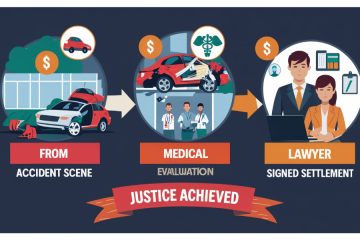Avoiding Legal Pitfalls: Essential Tips from an Experienced Personal Injury Attorney

Navigating the complex world of law can be daunting, especially when it comes to personal injury cases. Whether you’ve suffered an injury due to someone else’s negligence or you’re simply keen on staying informed, understanding the nuances of personal injury law is crucial. In this comprehensive guide, we’ll delve into essential tips provided by an experienced Personal Injury Lawyer to help you avoid legal pitfalls and make informed decisions.
Understanding Personal Injury Law
What is Personal Injury?
Personal injury law encompasses legal disputes that arise when an individual suffers harm from an accident or injury, and someone else might be legally responsible for that harm. These cases can range from slip and fall incidents to more complex cases like medical malpractice.
Why It Matters
The impact of personal injury goes beyond physical harm; it can lead to significant financial, emotional, and psychological burdens. Understanding your rights and the legal process is vital in ensuring you receive fair compensation and justice.
Essential Tips from a Personal Injury Attorney
Know Your Rights
- Educate Yourself: Familiarize yourself with the basics of personal injury law in your state.
- Seek Legal Advice: Consult with a personal injury attorney to understand your specific situation.
Act Swiftly but Wisely
- Timely Reporting: Report the injury immediately to relevant authorities or parties.
- Document Everything: Keep detailed records of the incident, medical treatments, and related expenses.
Choosing the Right Attorney
- Specialization: Ensure the attorney specializes in personal injury law.
- Experience and Reputation: Research their past cases and client reviews.
Understanding Settlements
- Negotiations: Be prepared for settlement negotiations; understand the worth of your claim.
- Decision Making: Decide whether to settle or proceed to trial based on informed advice.
Navigating the Legal Process
- Legal Procedures: Familiarize yourself with the legal process, including filings and court proceedings.
- Patience is Key: Understand that legal proceedings can be lengthy and require patience.
Avoiding Common Mistakes
- Hasty Decisions: Avoid accepting the first settlement offer without proper evaluation.
- Communication: Limit communication with the other party’s insurance company without legal advice.
Case Studies: Lessons from the Courtroom
To give a clearer picture, let’s examine a few case studies where understanding personal injury law made a significant difference.
Case Study 1: Slip and Fall at a Grocery Store
- Scenario: A customer slips on an unmarked wet floor, suffering a back injury.
- Outcome: Proper documentation and timely legal action resulted in a fair settlement covering medical expenses and lost wages.
Case Study 2: Medical Malpractice in Surgery
- Scenario: A surgical error leads to prolonged health issues for the patient.
- Outcome: Expert legal representation and thorough medical evidence secured compensation for the patient’s ongoing medical care.
The Role of a Commercial Litigation Attorney
In some cases, personal injury disputes may overlap with commercial litigation. A Commercial Litigation Attorney can navigate these complexities, especially when the injury involves a business or corporate entity. Their expertise is crucial in cases like product liability or injuries occurring in a commercial setting.
Navigating the Legal Landscape: A Deeper Dive
Personal Injury Law: Beyond the Basics
Understanding Liability
- Negligence: The cornerstone of most personal injury cases. Proving negligence is critical to establishing liability.
- Strict Liability: In certain cases, such as product liability, the focus is on the defect of the product rather than the negligence of the manufacturer.
Compensation: What You Can Claim
- Medical Expenses: Covers current and future medical bills related to the injury.
- Lost Wages: Compensation for income lost due to the inability to work.
- Pain and Suffering: Addresses the physical and emotional distress caused by the injury.
The Importance of Evidence
Collecting and preserving evidence is paramount in personal injury cases. This includes:
- Photographic Evidence: Photos of the accident scene, injuries, and anything relevant.
- Witness Statements: Accounts from people who witnessed the incident.
- Expert Testimony: Professionals who can provide insights into the cause and impact of the injury.
Settling vs. Going to Trial
- Pros and Cons of Settling: Faster resolution and less costly, but might result in lower compensation.
- Trial Considerations: Potentially higher compensation but involves more time, expense, and uncertainty.
The Emotional Aspect of Personal Injury Cases
Dealing with a personal injury case can be emotionally taxing. It’s essential to:
- Seek Support: Engage with support groups or counseling services.
- Stay Informed: Knowledge about your case can alleviate some anxiety.
Future-Proofing Against Personal Injury
- Preventative Measures: Adopt safety practices in daily activities.
- Insurance: Ensure adequate insurance coverage for potential accidents.
The Power of Expert Legal Representation
Choosing the Right Attorney
- Personality and Comfort: Choose an attorney you feel comfortable working with.
- Communication: Look for someone who communicates clearly and keeps you informed.
The Attorney-Client Relationship
- Trust and Transparency: A solid attorney-client relationship is built on trust and open communication.
- Collaborative Approach: Work closely with your attorney, providing all necessary information and documentation.
The Role of Technology in Personal Injury Cases
In today’s digital age, technology plays a crucial role in personal injury cases. From gathering evidence to presenting it in court, technological advancements have revolutionized the way these cases are handled.
Digital Evidence
- Surveillance Footage: Often critical in proving how the incident occurred.
- Digital Records: Medical records, texts, emails, and social media posts can all serve as evidence.
Technology in the Courtroom
- Virtual Reality: Used to recreate accident scenes.
- Video Testimonies: Allow witnesses who cannot be physically present to contribute.
Future Trends in Personal Injury Law
The field of personal injury law is constantly evolving. Staying abreast of these changes is essential.
Emerging Trends
- Increase in Gig Economy Cases: With the rise of the gig economy, new types of worker injuries and liability questions are emerging.
- Focus on Mental Health: Recognizing the psychological impact of injuries is becoming more prevalent in personal injury claims.
Staying Informed
- Continuous Learning: Keep updated with the latest legal developments.
- Networking: Engage with legal forums and communities for shared knowledge and experiences.
Your Action Plan: Post-Injury Steps
If you find yourself in a personal injury situation, having a clear action plan is vital. Here’s what you need to do:
- Seek Medical Attention: Your health is the top priority.
- Report the Incident: Notify the relevant authorities or responsible parties.
- Gather Evidence: Take photos, collect names of witnesses, and keep all documentation.
- Consult an Attorney: Seek legal advice as soon as possible.
Conclusion: Navigating the Legal Maze with Confidence
Personal injury law can be complex, but with the proper knowledge and legal representation, you can navigate it successfully. Remember, each case is unique, and an experienced Personal Injury Lawyer can guide you through the specifics of your situation. Stay informed, stay prepared, and don’t hesitate to seek legal assistance when needed.
Empowerment in personal injury cases comes from understanding your rights and the legal system. With this comprehensive guide, we hope to provide you with the knowledge and tools necessary to face any personal injury challenges confidently.



















